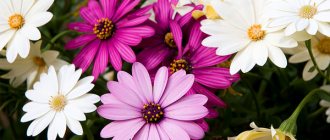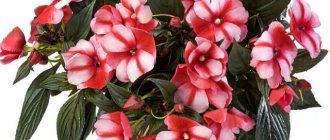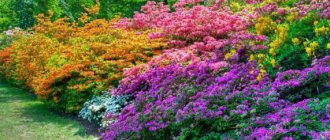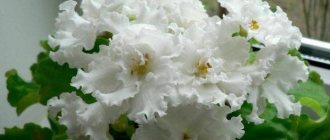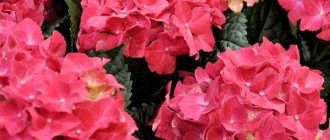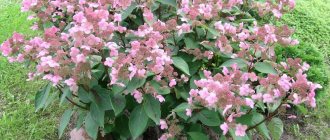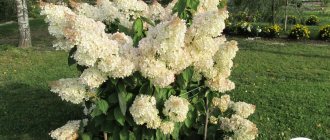Hydrangea is an airy flower with multi-colored “caps”
When you see hydrangea, you get a feeling of lightness and airiness. Looking at these flowers, you just want to pick a fluffy bouquet of multi-colored flowers or plant whole rows of them so that their multi-colored “caps” are on both sides of the path. The hydrangea plant belongs to the genus Hydrangeaceae. Among its species there are trees with simple leaves or shrubs. Hydrangea can also be liana-shaped. The flowers are small in size, collected in spherical inflorescences, no aroma. However, these inflorescences themselves immediately catch the eye. They give the plant a decorative appearance.
Interesting: hydrangea not only has a beautiful appearance. She is also healing!
Planting hydrangea
This plant should be planted in early spring or autumn. When the climate is cold, it is recommended to plant young hydrangeas from cuttings in the spring to better withstand frosts in the next winter. Before planting, it is necessary to add organic and mineral fertilizers to the soil and prepare a hole in which to pour peat. Don't forget that this plant needs to shorten its roots.
The plant is most often planted singly, sometimes in groups on the lawn. The planting hole should have dimensions of 30x30x30 cm, the distance from one hydrangea to another should be about one meter. When planting, you should not bury the root collar. In the spring, during planting, annual shoots should be shortened by three or four buds. The bush that has been planted must be well watered and covered with peat or humus.
Hydrangea propagation
- Dividing the bush
The bush is divided both in spring and autumn. To do this, the plant is dug up, then divided into a number of bushes so that the division contains a renewal bud. Then the bush is planted in the prepared place.
Cuttings are usually harvested in April. To do this, take green twigs from the crown and cut them at right angles. Afterwards they are planted in a fertile extract. When rooting has occurred, they are planted in a growing bed. The plant will grow in it for 1-2 years, after which it is transplanted to a permanent place outside.
In the first year after planting, the plant should be covered for the winter, and the flowers should be picked off from young cuttings. Cuttings in winter are allowed only for large-leaved hydrangea. To do this, in mid-autumn you should dig up the parent plant and plant it in a pot at home. The temperature should be 0+2 °C. And at the beginning of winter, the temperature for growing should be +7-10 °C. The plant must be replanted in soil made from humus, sand, peat, turf soil (2:1:1:4). February is the time when the plant comes to life and begins to grow. After this, you need to cut the green cuttings and root them in a pot of nutritious soil. The leaves should be shortened by 2 times.
It is necessary to bend the shoots to the ground (they must be no older than one year), leaving the top of the shoot 20 cm long outside. In the fall or early spring of next year, the shoot that has taken root must be separated and replanted.
Hydrangea is rarely propagated by grafting and seeds.
Hydrangea care
- Introduction of fertilizing from mineral and organic fertilizers (you need to fertilize in moderation, because voluminous inflorescences can bend the branches of the bush).
- Watering. It is recommended that the acidity of water for irrigation not exceed 5.6 pH. This plant loves moisture and should not be allowed to dry out.
- Loosen the soil three times per season to a depth of 5-10 cm.
How does pruning happen?
- In large plants, the inflorescences that have bloomed are cut off in the fall.
- Young bushes are pruned in the spring, before buds appear. In order for the plant to be as lush as possible and to be able to survive the winter, the young shoots of the bush are pruned to four buds.
- If you deliberately prune the cuttings over a period of 4-5 years, you will get an excellent small hydrangea tree.
- In the first year of flowering cuttings, you need to pick off the flowers. This will help the bush gain more strength to bloom beautifully next season.
Change in color of hydrangeas
New varieties of hydrangeas and large-leaved species can change the color of the flowers. To do this, you need to use different dyes, which can be bought at a store specializing in fertilizers. If you want your hydrangea to acquire a blue tint, you need to use iron or aluminum crystals when watering twice a week. Aluminum sulfate will also work. If you want hydrangea to bloom with pink inflorescences in the garden, then you need to use a solution of potassium permanganate. Peat can also affect the color of hydrangeas. You need to water the plant with peat infusion - change the color of the hydrangea, add excellent fertilizer for the soil and roots of the plant.
Sheltering the plant for the winter
It is better if the shelter for the winter is horizontal. This way you will preserve the flower buds that form on the branches of the plant. This way the plant will bloom early.
What types of hydrangea are there?
There are many types of hydrangea. There are species that suffer from intense heat, and there are also those that like to grow in partial shade. There are also types of hydrangea that prefer to grow under the rays of the hot sun. Therefore, we will consider those types of hydrangea that best take root and grow in our country.
Growing in the wild
In nature, there are more than 280 thousand representatives of the order Tsvetkovy, differing in size, type of inflorescences, timing and duration of flowering. Some of them are real “monsters” worthy of becoming the main characters of “horror films”.
Posidonia oceanica
These giant flowers grow underwater, at a depth of about 30–50 meters. They grow up to 8,000 meters in length, forming entire green massifs in the underwater space.
The giant plants were discovered by Spanish oceanologists in 2006. This family includes nine species of sea grasses with erect or creeping stems.
Posidonia oceanica is a plant useful for the biosphere, enriching water with oxygen and serving as a home for many small fish and crustaceans.
Victoria amazonica
This large flower with leaves two meters in size can be found in South America, on the Guyana and Amazon rivers. Its huge leaf plates, reminiscent of frying pans due to their round shape and curved edges, can support a weight of more than 30 kilograms. You can walk on them without fear of getting your feet wet, just like on dry land. Representatives of the indigenous population of this region even use them to move on water, instead of rafts.
On the outside of the leaves of this huge water lily there are long spine-like shoots that drive away fish and other animals. Inside the “frying pan” there are drainage channels that accumulate liquid.
The flowers of the plant, similar in shape of petals and color to enlarged lotus buds, spend most of their life in water, appearing above the surface only for three days, filling the surrounding space with a subtle, delicate aroma.
Amorphophallus titanica
This amazing plant grows up to three meters in height - the tallest flower on the planet. People often call it: “Voodoo lily”, “corpse flower” or “snake palm”.
In the initial stage of development, Amorphophallus has the appearance of a large, heavy tuber with a diameter of 50 centimeters, weighing half a centner. The lifespan of this plant is about forty years. But it blooms only a few times over these four decades.
With the onset of spring, a stem shoot with a characteristic spotted color begins to grow from the tuberous rhizome, which very quickly increases in height, adding seven centimeters every day. As a result, a huge flower blooms on it, weighing up to 75 kilograms and up to two meters high .
There are practically no Amorphophallus left in the wild. Currently, these large plants can be found in some greenhouses and botanical gardens, where they bloom extremely rarely. Visitors to the Cambridge University Botanical Garden were able to “admire” one of these blooms on July 18, 2015, when the “corpse flower” growing there opened its petals for the first time in 11 years.
In the process of opening the petals, half of the Amorphophallus inflorescence heats up to +40 degrees, spreading around itself a strong stench, reminiscent of the aroma of “rotting carrion.” The flowering of the plant lasts about two weeks, but the bud itself lives only a few days, after which it dies. In its place, leaf plates grow up to 6–7 meters in height.
Carnegie
A unique representative of its species, the shape of its shoots resembles a huge candelabra. It is the tallest thorny plant, reaching 18 meters.
This giant grows in the Sonoran Desert, located in part of Southeastern California and Arizona. Its large white (sometimes reddish) flowers are covered with many stamens, which are so large that they can accommodate a fairly large bird's nest. The white branch of the carnegia or saguaro is the symbol of the state of Arizona.
The fruits of the plant are edible. A special starter is prepared from its juice, which is used as a treat at traditional Mexican holidays.
The saguaro is a protected plant, causing harm to which will result in imprisonment. To protect the unique succulent from being removed from the territory of the protected reserve, microchips are implanted into young specimens that track their locations.
Kirkazon
Kirkazon (Aristolachia) is a powerful herbaceous vine, reminiscent of a huge smoking pipe, stretching up to 33 meters in length and 27 meters in width.
An interesting feature of this giant is the arrangement of the leaves, one above the other, like bricks. Kirkazon flowers are showy and beautiful, which attracts insects that feed on the flower. The flowering period ranges from 5 to 25 days. About 480 varieties of this plant are found in the tropics. Some of them are grown as ornamental crops in greenhouses and parks.
The flower is poisonous, eating it can cause kidney damage!
Puya Raimondi
This powerful, large flower has a spadix-shaped inflorescence about 10 meters long.
Puya grows on the mountain peaks of the Andes, where it has to withstand extreme weather conditions. A special substance contained in plant tissue helps with this. Its structure is similar to antifreeze, so the indigenous people of Peru use it as “insulation” for the walls of their homes or as fuel. Currently, this ancient species is endangered.
Its attractive bell-like buds open when the plant reaches 50-100 years of age.
Rafflesia arnolda
These huge flowers received their name in honor of the British biologist Joseph Arnold, who discovered them in the jungles of the island of Sumatra, and the founder of modern Singapore, the English colonialist, Sir Thomas Stamford Raffles.
Rafflesia is the largest flower on Earth and a parasitic plant. It does not have roots, stems or full leaf shoots. Its body consists of thin threads, reminiscent of mycelium, attached to liana-like plants growing next to the flower. From them it receives the necessary nutrients, but does not cause harm to the donor vines.
The Rafflesia flower grows up to 60–100 cm in diameter, and the weight of the monster bud reaches 11 kilograms. The petals are purplish-red, fleshy, with convex warty formations of a light shade, about 3 centimeters thick, growing up to 46 centimeters in length. The aroma of this “mastodon” is appropriate. The “dead lotus” smells like rotten meat, which attracts dung flies, which are pollinators.
Due to its powerful, fetid aroma, Rafflesia is often called the “dead lotus” or “corpse lily.”
The flowering period of this parasite is short, only 4 days. Full ripening of the bud occurs within a few months.
Velvichia is amazing
These large flowers, about 8 meters long and two meters wide, grow on the rocks of the Namib Desert.
They belong to relict species that live up to 2,000 years. Plants obtain the moisture they need for life from fogs that periodically occur in the desert due to temperature changes. After dying, the Welwitschia leaves, split into thin, long strips, are carried across the desert by the wind.
Cylindropuntia bigelow
A beautiful, powerful shrub with a tall, slender stem about one meter high, turning into a spreading tree-like crown. The total height of the plant, otherwise called Prickly Pear Bigelow, is about 2.8 meters.
Its tree-like shoots are covered with small formations in the form of tubercles with smooth outlines, on the tops of which there are bright lemon-colored spines with caps at the tips.
Prickly pear flowers are attractive, bright yellow, with an elongated flower tube of a carmine hue, opening from late winter to May. The thorny branches of the bush serve as protection for small animals (hamsters or other rodents) and are a nesting site for birds. This species grows in the USA and Mexico.
Corypha umbellata
This palm, which comes from the Arecaceae or Palmaceae family, has gained fame due to its incredible growth, reaching 25 meters, as well as the huge size of the inflorescences, growing up to 8 meters. The trunk of the palm tree grows up to one and a half meters wide.
It blooms once in a lifetime, at 30–80 years of age. Its flowers, collected from paniculate-cob inflorescences, have a bright aroma that spreads far throughout the area.
Interesting fact: the inhabitants of the Philippines use the leaves of this plant to make various items, including hats, in honor of which a special holiday is held in May, Buntal.
Stapelia gigantea
This succulent with fleshy, large stems that accumulate moisture is truly gigantic in size . For which he received the corresponding nicknames: “Zulu Giant” and “Toad Flower”.
Grows in the jungles of South and Central Africa. The bush itself is of medium size: up to 60 centimeters in height. In appearance it differs little from ordinary cacti.
A distinctive feature of the plant is its flower in the form of huge stars with petals 35 to 40 centimeters long, covered with a fringe in the form of “cilia” along the edges and closer to the center. These buds look unusual and attractive, but they are repulsed by the disgusting smell of “rotten meat”.
Pollinators of succulents are flies. Despite the unpleasant stench, it is valued as an ornamental crop and is grown in southern gardens as a spectacular potted plant.
African Hydnora
This unusual representative of the Tsvetkov family lives in the desert regions of East Africa.
The strange shape and properties of the parasite help the plant withstand harsh desert conditions, including constant droughts and temperature changes. Gindor receives its nutrition from neighboring crops, the roots of which it wraps around with suckers.
Its rhizome and all shoots grow deep in the soil. After rain, carnivorous flowers appear on the surface, about 15 centimeters in size. Their internal color is bright orange, and on the outside the lumpy buds have a brownish tint.
When opening, the flowers emit a foul aroma, attracting dung beetles and flies, which are pollinators and at the same time “dinner” for the flower. In Madagascar, Gindorah is considered a delicacy.
Garden flowers names and photos
One of the main elements of any garden are flowers. They make it beautiful, bright and memorable. Their variety is so great that making a choice sometimes becomes very difficult.
This page is about garden flowers - a catalog with photographs and names , as well as a description of the planting and flowering period of these plants. You can also familiarize yourself with the catalog of indoor plants. We’ll start with how to use the garden flower catalog to choose the best specimens for your site.
Selecting from a catalog of garden flowers for your garden
Location is the main criterion that is responsible for the life and active development of plants. If you plant light-loving flowers in a dark place, then they will not be able to delight their owners with their beauty for a long time. This means you need to know in advance the insolation in your own area and the attitude of your favorite plants to light. Therefore, before selecting plants, decide which area you want to plant with garden flowers. After this selection, you can move on to the next point.
Features of flowers. According to morphology, flowers are divided into annual (marigolds, petunias) and perennial (hostas, daisies, lilies). The difference lies in the different periods of their life and development. The first type is cheaper, but it grows only one year; the next year it is necessary to purchase plant material again. Using the catalog search form, you can sort flowers by life expectancy. Perennial plants can be planted only once, and they will delight their owners every year. The second type is more expensive than the first.
Amorphophallus titanica
A tropical plant known for its largest inflorescences. Amorphophallus titanica has a thick stem with a single leaf. The maximum height is 2.5 m, the weight of the flower can reach 75 kg. It lives for about 40 years, during which time it blooms 3–4 times.
The flower is striking in its gigantic size, it has a bright red color and smells foul. The flowering period lasts about two weeks, but you can admire them only for the first three days, then the process of withering begins.
Amorphophallus titanica grows well in natural conditions, but does not like to obey people. There are only 122 botanical gardens in the world whose employees can boast that they managed to grow this plant.
List of colors alphabetically from a to z
Flower names in alphabetical order by letter
- Radermacher
- Broom
- Rhubarb
- Reo, tradescantia reo
- Rhipsalidopsis, Easter cactus
- Robinia, Acacia
- Rogersia
- Rhodiola
- Rhododendron
- Rose, rosehip
- Roycissus
- Sundew
- Rudbeckia
- Rousselia, coral plant
- Ruellia
- Rowan
- Fieldfare
- Hazel grouse, fritillaria
- Cycad, Cycas
- Salpiglossis
- Boxwood
- Sanvitalia
- Sansevieria, pike tail, mother-in-law's tongue
- Sarracenia
- Safflower
- Plumbago
- Selaginella, the resurrection plant
- Saintpaulia, Usambara violet
- Setcreasia
- Sidalcea
- Siderasis
- Syngonium
- Feverweed
- Sinningia, Gloxinia
- Sinyukha, polemonium
- Lilac
- Sitnik
- Scabiosa, widow, bark bark
- Skimmia
- Scopolia
- Mackerel, yellowberry
- Plum, Prunus
- Smilatsina
- Currant
- Snowberry
- Snooze
- Saltirolia, Gelksina, Helksina
- Solnechnik, Heliopsis
- Sunflower
- Sorbocotoneaster
- Pine
- Sophora
- Sparmannia, indoor linden
- Spathiphyllum
- Spiraea, meadowsweet
- Sprekelia, sprekelia
- Stapelia
- Stahis
- Stefanandra
- Stephanotis, Madagascar jasmine
- Ostrich - fern
- Strelitzia, bird of paradise
- Arrowhead
- Streptocarpus, stemmed violet
- Strobilanthes
- Stromanta
- Sumac
- Sutera, bacopa
- Schizanthus, schizanthus
- Scaevola
- Scindapsus, Epipremnum
- Scirpus
- Tobacco
- Takka, bat
- Tamarix, comber
- Tetrastigma
- Tiarella, tiarka
- Tillandsia, Spanish, Louisiana moss
- Thyme, thyme
- Tiss
- Tithonia
- Tladianta
- Tolmia
- Bearberry
- Thick-walled
- Crassula, crassula, money tree
- Torenia
- Tradescantia
- Trillium
- Tritsirtis
- Thunbergia
- Thuja
- Pumpkin
- Yarrow
- Tulip
- Uvularia
- Phalaenopsis - orchid
- Fatsia, Aralia
- Fatshedera
- Violet, viola
- Physalis, flashlight
- Physostegia
- Ficus
- Philodendron
- Date fruit
- Fittonia
- Phlox
- Forsythia
- Fortunella, kincan, kumquat
- Phragmipedium - orchid
- Fuchsia
- Haworthia
- Hakonechloa
- Hamedorea
- Chamelacium, wax myrtle
- Hathiora
- Houttuinia, huttinia, houtinia
- Hebe
- Helona
- Chaenomeles, Japanese quince
- Hirita
- Chlorophytum
- Hop
- Hovea, Kentia
- Hoya
- Hosta, funkia
- Corydalis
- Chrysanthemum
- Chrysanthemum, dendranthemum
- Ceanothus, Redroot
- Coelogina - orchid
- Celosia
- Celosia
- Cereus
- Ceropegia
- Tsercis
- Cyanotis
- Cyclamen
- Cyclamen, dryweed, alpine violet
- Cymbidium - orchid
- Cohosh
- Cineraria
- Zinnia
- Cyperus, satiate
- Cissus, indoor ivy, birch
- Citrus
- Bird cherry
- Blueberry
- Chernogolovka, prunella
- Chokeberry, chokeberry
- China, sweet pea
- Mock orange, garden jasmine
- Sage
- Mulberry, Here
- Scheffler
- Rose stock, mallow, mallow, alcea
- Setaria, bristlecone
- Shield plant, dryopteris - fern
- Eucalyptus
- Edelweiss
- Eichornia, water hyacinth
- Exakum
- Endymion
- Evening primrose, night candle, aspen tree
- Aeonium
- Epipremnum
- Episcia
- Epiphyllum
- Eremurus, shiryash
- Erika
- Eschynanthus
- Eucomis, eucomis
- Eustoma, lisianthus, Japanese rose
- Eucharis, Amazon lily
- Echeveria
- Echinocactus, hedgehog cactus
- Ekhmeya
- Eschszolzia
- Yucca
- Jacobinia
- Yasenets, burning bush
- Yasenets, burning bush
- Cerastium, cerastium
- Woodruff, asperula
- Woodruff, asperula
- Jatropha
Choosing white flowers for the garden
What does white mean? For most, it is a symbol of purity, innocence, joy, happiness, carelessness, and childhood.
And if this color is not entirely practical in everyday life, then why not transfer it to the garden.
Like interior design, landscape design in white colors will allow you to achieve a visual increase in space, lightness, and a feeling of freedom.
Therefore, today we will look at what white flowers there are for the garden, and we will present the main assortment that you can use when creating a flower garden.
Hibiscus
Hibiscus belongs to the Malvaceae family. They grow mainly in the subtropics and tropics. However, this plant has long been decorative. It is bred in greenhouses, gardens and even grown on windowsills.
At the moment it is impossible to say exactly how many species of hibiscus there are. The approximate figure is 300. The largest flowers are found in herbaceous hibiscus. It grows in the form of small bushes. Perennial. Its inflorescences can reach 40 cm in diameter. In addition, they are distinguished by a variety of colors: pink, red, white. An impressive sight. In shrubby and tree-like plant species, the inflorescences are much more modest (up to 20 cm).
Interesting fact: Hibiscus has a bad reputation, being called the “flower of death.” Despite these superstitions, people are not afraid to grow it at home or in the garden.
Selection of an assortment of herbaceous species with white flowers
In the world of plants, white color is not uncommon; you can see it every spring, when fruit trees begin to bloom, and the first flowers - snowdrops - cover the sunny forest glades.
Modern genetics and selection today boast a long list of developed varieties, but how not to get confused in this diversity? After all, flowers with white flowers have different sizes, corolla shapes, number of petals, etc.
Let's divide the species and varieties into three groups - annuals and biennials, perennials and bulbous ones. Many of the names will be familiar, especially to those who have been interested in gardening for a long time, but for beginners this information will be very useful.
Peonies
Peonies are common in the subtropics and temperate regions of North America and Eurasia. Herbaceous perennials, although there are also tree-like (shrubs).
This flower is highly valued by gardeners. In total, there are about 6.5 thousand plant varieties. The most spectacular tree varieties of peonies are considered to be Sisters Kiao (petals of pink and white color, densely double), Black Pirate (dark burgundy shades).
Their inflorescences reach 25 cm in diameter. One branch of such a plant can replace a whole bouquet. Herbaceous varieties of peonies are somewhat inferior to tree varieties in size, but not in beauty.
Examples of garden design in white
Perhaps someone will say that white landscape design is boring and uninteresting. However, only those who have not seen anything like this in person can think so.
After all, this is not a plain white wall. This is a voluminous composition, where white color effectively combines with green, large flowers contrast with small ones, tall ones with low ones. Only by planting density can you radically change the entire look.
And if, in addition to herbaceous plants, you select shrubs and trees that bloom with white flowers or have white foliage, then such a picture will evoke admiring glances not only from neighbors, but also from friends and relatives.
Here are some examples of successful garden decoration with plants with white flowers. Look how light and clean these compositions look.
Don't be afraid to use just one color in your garden. It will look stylish and modern. The main rule is a harmonious combination of all landscape elements, including buildings, small architectural forms and, of course, plants.
| The size of the plant is very important. If a mixborder is arranged in the garden, then the largest and tallest plants should be planted at the very end, and small and abundantly flowering plants should be planted at the beginning. My catalog of garden flowers contains photographs, thanks to which you can navigate by plant size. All seed packages usually indicate the sizes of interest. If you buy seedlings, it is better to find out all the necessary data from reliable sources. |
Outdoor and indoor crops grown by humans
Large flowers are a real miracle of nature. They have been growing on our planet for many hundreds of years and never cease to amaze with their unusual, sometimes strange or scary forms. Among garden and indoor plants there are also record holders, such as:
Roses
People have been growing these beautiful plants for a long time, breeding new, interesting species that amaze with their beauty, unusual color, exquisite aromas or size. For example, the bush variety Lady Banks, bred in 1885, is considered the largest rose in the world.
The size of its trunk is about 3.7 meters in diameter (at the base - about 4 m). The shoots of the plant, rising 2.5 meters above the ground, are decorated with more than two hundred thousand terry buds.
Tulips
These beautiful flowers amaze the imagination with their variety and colorfulness of shades, shapes and sizes.
The largest representative of this species is considered the Temple of Beauty, bred in 1956 by the Dutch breeder Derek W. Lefeber. The size of its bud is 14 cm. The height of the plant can reach a meter. Large varieties also include: Casa Grande, with orange-scarlet petals, the diameter of which at the base is 14 cm, with a stem length of 50 cm. And the variegated Libretto Parrot, with an inflorescence 8 cm long.
Calla lilies
They are real “giants” among ornamental flowering crops. Capable of growing up to 2.5 meters in height (Ethiopian calla lily). The size of the plant leaves is about 30 cm.
In Russia, this attractive flower was previously called “whitewing” because of the unusual shape of the petals, reminiscent of the snow-white wings of an angel.
For many peoples, calla lilies are considered a symbol of death, so these flowers can often be found in cemeteries. However, in fact, this unpretentious, beautiful flower has nothing to do with the other world; it grows well in the garden or as a potted plant in the apartment.
Peonies
This spectacular subshrub grows up to a meter in height.
At the end of spring, beautiful multi-layered buds with simple or double petals, the size of which range from 15 to 25 centimeters, bloom on it. The most famous plant varieties include: “Sarah Bernhardt” and “Festiva Maxima”.
Hibiscus
Belongs to the genus Malvaceae. In its natural habitat, the size of this plant is about 2.5 - 5 meters in height, with a crown girth of 1.5 to 3 meters. The diameter of the flowers is from 10 to 12 centimeters.
Valued for its attractive appearance, intensity and duration of flowering. Used as a garden and indoor crop.
Clematis
A beautiful climbing plant with large petals ranging from 8 to 15 cm in size, in a wide variety of shades.
Translated from ancient Greek, the name of this culture sounds like “a branch of grapes.” It grows in height up to 4 meters.
Hydrangeas
A popular decorative crop, actively used in floral design.
Hydrangeas are planted in parks and gardens as a “hedge”; their large, bright flowers are used in spectacular bouquets. The average plant size is from 1 to 3 meters, depending on the species.
Sunflower
This bright, “sunny” flower with large round inflorescences located at the top of a long stem up to 3.5 meters in size is familiar to everyone.
Sunflowers are grown in temperate and warmer climates. The homeland of the plant is Mexico. The tallest specimen was grown in Holland in 1986. Its trunk had a height of 7.76 m. And the plant with the largest inflorescence was discovered in Canada. Its diameter was 8 cm.
One can only envy the art and imagination of nature, which creates plants of enormous size, surprising with their terrible or, conversely, beautiful appearance. Therefore, we can only enjoy the “fruits of her creativity” and admire the result.

